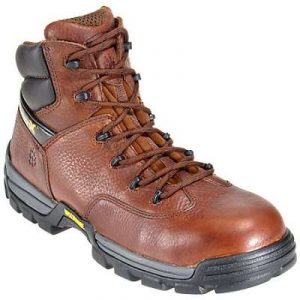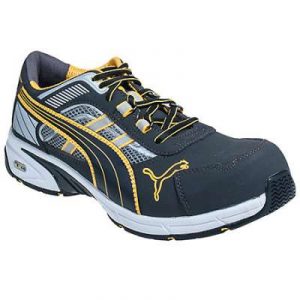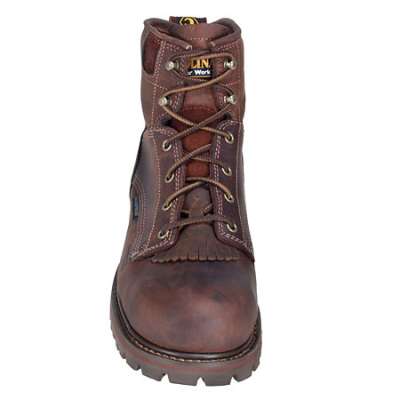When you wear safety toe boots or shoes to work on a regular basis, “convenience” is not the first word that comes to mind. It’s no secret that safety toe caps add weight to your boots and can be uncomfortable by the end of the day. Thankfully, technology has come a long way on recent years to develop new methods of protecting your toes that still hold up to ASTM standards. One of the latest innovations is the lightweight, non-metallic composite toe caps. These built-in safety caps offer many benefits to you while still protecting at the same level as their steel alternatives.
 This Wolverine Men’s 2292 Guardian CarbonMAX Safety Toe EH Boot is made with Wolverine’s patented CarbonMAX non-metallic safety toes.
This Wolverine Men’s 2292 Guardian CarbonMAX Safety Toe EH Boot is made with Wolverine’s patented CarbonMAX non-metallic safety toes.
But what exactly is it made out of?
Composite toe caps are produced from a number of materials and will vary from one manufacturer to the other, but the most common inputs on composite are Kevlar, carbon fiber, plastic, and fiber glass. Wolverine CarbonMAX, for example, include toe caps made from durable carbon fiber and are available in a wide variety of work boots and shoes. The reason composite toe caps are lighter in weight than steel is primarily due to the technology involved in the production; nanotechnology creates thin layers of fibers that are fused together to create a strong cap wall that’s thinner than the walls of steel toe caps. This not only weighs less due to less material, but it also makes the toe space larger inside, leaving more room for movement and creating less rub. Bare in mind, thinner walls do not mean less protection! All safety toe caps undergo rigorous inspection and are required to meet the same impact and compression standards as steel options.
Why choose composite?
There are a number of benefits composite toe caps have brought to the workplace in addition to the ones we’ve already mentioned above (more toe room, lighter in weight). Working Person’s Store has lots of options for you. While each person has a preference of their own, here are some of the most common reasons to wear composite toe shoes or boots, according to our customers:
Lightweight toe caps make athletic shoes feel like athletic shoes. When you do a lot of walking or standing on your job, particularly when you’re on concrete all day, your feet, ankles, and knees take a beating. Adding extra weight from steel toes makes the problem worse. There are a wide variety of athletic shoe options available with composite toes, which help keep the lightweight nature of these shoes true to what you are used to wearing during your leisure time. These Men’s Puma 64.256.5 Composite Toe Grey ESD Athletic Work Tennis Shoes feature a lightweight composite toe cap for the best combination of work safety compliance and the comfort of athletic shoes.
These Men’s Puma 64.256.5 Composite Toe Grey ESD Athletic Work Tennis Shoes feature a lightweight composite toe cap for the best combination of work safety compliance and the comfort of athletic shoes.
Non-metallic composite toes don’t get cold or hot. Carbon and plastic on non-conductive, that means they don’t absorb cold or heat like steel. This makes your insulated work boots warmer without sacrificing safety.
Composite toe boots don’t conduct electricity. If safety in hazardous electrical environments is a concern for you, composite toe caps offer you the added benefit of non-metallic safety for a little extra protection. Of course, you’ll also want to make sure your boots are certified EH, or Electrical Hazard rated, to be 100% sure you’re safe in certain hazardous situations.
Composite toe boots and shoes do not set off metal detectors. (That is, unless they contain metal elsewhere in their design.) If you work in a location that requires you pass through security on a regular basis, composite toe boots or shoes are a time-saving option. Your footwear won’t be the reason you set off any metal detectors – so as long as you remember to take your keys out of your pockets – and you should get through a lot faster and without removing your shoes.
Composite toe boots and shoes have become a preferred option for safety footwear. They have been around long enough and through enough testing to prove their safety and functionality on the job. The rigorous testing and staunch safety standards ensures your safety should you ever have the unfortunate opportunity to need the safety features, which we certainly hope never happens.




